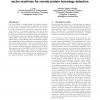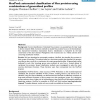51 search results - page 3 / 11 » Classification of protein sequences by means of irredundant ... |
RECOMB
2002
Springer
14 years 8 months ago
2002
Springer
One key element in understanding the molecular machinery of the cell is to understand the meaning, or function, of each protein encoded in the genome. A very successful means of i...
BMCBI
2006
13 years 8 months ago
2006
Background: MannDB was created to meet a need for rapid, comprehensive automated protein sequence analyses to support selection of proteins suitable as targets for driving the dev...
ISMB
1994
13 years 9 months ago
1994
Weconsider the problem of parsing a sequence into different classes of subsequences.Twocommonexamplesare finding the exons and introns in genomicsequences and identifying the seco...
BMCBI
2007
13 years 8 months ago
2007
Background: Correct identification of individual Hox proteins is an essential basis for their study in diverse research fields. Common methods to classify Hox proteins focus on th...
BMCBI
2004
13 years 8 months ago
2004
Background: Hidden Markov Models (HMMs) have proven very useful in computational biology for such applications as sequence pattern matching, gene-finding, and structure prediction...


